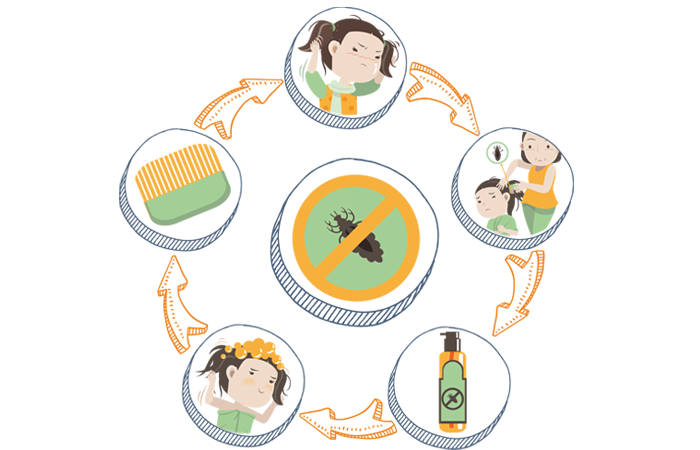Locking down head lice
In Conditions
Follow this topic
Bookmark
Record learning outcomes
As the country gears up for children returning to school this September, anxiety levels will be high among parents for more reasons than usual. But head lice don’t have to be one of them
Though they be but little, they be fierce… Or uncomfortable, at least. Head lice are dreaded by parents and children alike and as the summer holidays draw to a close, these tiny creatures are likely to be moving further up families’ lists of potential bugbears. With the realities of school life a little different this September as a result of the Covid-19 pandemic, knowing how to effectively manage head lice infections and other parasites will help in giving parents one less thing to worry about.

Pharmacy teams can be on hand to help with all the necessary information and tools to tackle head lice and other parasites, as well as product recommendations for treatment and self care tips to prevent infections spreading.
Get introduced
Humans are uniquely plagued by head lice. They do not live on, and cannot be transferred via, animals. They are extremely common, especially in children between the ages of four and 11, and while outbreaks commonly occur in September when children return to school, they can happen all year round. Contrary to popular playground myths, head lice do not just live in dirty hair; they can be passed onto anyone via head-to-head contact. Having long hair does not make a person more susceptible either. It takes a mere 30 seconds – or even less – for a single louse to pass between heads, according to the British Association of Dermatologists (BAD).
Head lice are small brown or grey insects that live on the scalp. Adult lice can be visibly seen in the hair and are about the size of a sesame seed. A person with a head lice infection will have an average of 10 adult lice on their scalp at any time, but this can be higher.
The yellow or white eggs, known as nits, are about the size of a pinhead and are usually attached to hair close to the scalp. Empty eggshells can often be spotted further down the hair, too. Female lice can lay up to 100 eggs in their 40-day life cycle, which take between seven and 10 days to hatch. The new lice then get busy laying their own eggs within seven days, so it’s beneficial to get on top of an infection quickly.
Female lice can lay up to 100 eggs in their 40-day life cycle
Detective work
Pharmacy teams can help parents do the necessary detective work to uncover head lice by making them aware of symptoms and effective detection methods.
Head lice feed on blood and leave behind saliva, making the scalp itchy. But although it is often regarded as a key symptom, itching does not always occur with head lice. Dr Tess McPherson, consultant dermatologist and spokesperson for the BAD says: “The most common symptom of a head lice infestation is an itchy scalp. However, not everyone will experience this, so the only way to be sure is by taking a careful look at the scalp to inspect for nits – eggs attached to the hairs – or live lice.”
Detection combing is an effective way to inspect for head lice and so detection combs are vital tools in a head lice combat kit. These can be bought in the pharmacy and reused for future cases of infection, making them an economical investment. A fine-toothed, plastic comb with a spacing of 0.2-0.3mm is considered best. Parents also have some options: they can try either wet combing or dry combing their child’s hair. Dry combing is a quicker method, but wet combing is usually more effective, as the conditioner makes it harder for the lice to hold onto the hair.
Dry detection combing method:
- Use a wide-tooth comb to untangle the hair
- Use a detection comb starting at the roots, with the comb lightly touching the scalp, and brush to the end of the hair
- Trap lice between comb and thumb
- Comb each section three to four times.
Wet detection combing method:
- Wash the hair with any standard shampoo as normal
- Apply lots of conditioner
- Use a wide-tooth comb to untangle the hair
- Use a detection comb starting at the roots, with the comb lightly touching the scalp, and brush to the end of the hair
- Check the comb for lice and wipe or rinse it
- Work through the hair section by section so every area is checked
- Do this at least twice
- Once the whole head has been thoroughly combed and checked, the hair should be rinsed and dried.
In severe cases of head lice, the scalp may become infected and impetigo – a bacterial infection – may develop. If a child’s scalp is sore, they have swollen glands, a fever or feel generally unwell while they have head lice, they should be referred to the pharmacist or a GP. See this pharmacy scenario for more on impetigo.
It takes a mere 30 seconds for a single louse to pass between heads
Myth busters
• Head lice are not a reflection of a person’s hygiene. They thrive on any kind of hair, no matter how clean or dirty it is
• Head lice cannot fly, swim or jump. They only transfer from person to person by head-to-head contact, walking along hair strand
• Head lice are not preventable and should not be pre-empted. It’s almost impossible to prevent head lice entirely, although some steps can be taken to help stop them spreading, such as tying up long hair and avoiding head-to-head contact.
Dr Tess McPherson, consultant dermatologist and spokesperson for the British Association of Dermatologists, explains: “Chemical treatments shouldn’t be used as a preventative measure. This can encourage the resistant head lice to develop, making them even harder to get rid of.” In addition, medicated lotions and sprays should not be used to prevent head lice as they can irritate the scalp.
Regular detection combing is perhaps the best course of action so treatment can be started as soon as possible after infection, limiting the chance of passing it on.
Tackling treatment
Eradicating head lice can be a time consuming process, but everything parents need for the task can be bought from a pharmacy, including combs and different types of treatments. Pharmacy teams can also ensure that parents have all the necessary information regarding the different treatment methods, including the pros and cons of each.
- Wet combing
Wet combing – also known as the mechanical method – is a fairly time consuming but inexpensive and effective form of treatment. The removal process takes the same form as detection, outlined above. The charity Community Hygiene Concern – set up to protect people from common parasites found in the UK – also has a video of tips on wet combing.
When treating head lice, wet combing should be done on days five, nine and 13 after detection. Detection combing should also be done on day 17 to ensure all head lice and eggs have been removed. It is important to ensure that every part of the hair has been fully combed, as reinfection can be common. “This may happen if somebody in the family comes into contact with lice again, or the treatment was not fully effective. In particular, even with good combing, it’s possible for eggs to be missed, which later hatch causing re-infestation of lice,” explains Dr McPherson.
- Physical treatments
Physical treatments have their benefits as they kill head lice through a physical action, meaning that the lice can’t become resistant to the treatment. Physical insecticides contain ingredients including dimeticone, isopropyl myristate and cyclomethicone. Pharmacy teams can recommend that parents use two treatments a week apart to ensure they have killed all the head lice – including lice that may have hatched after the first round of treatment – as any remaining lice can cause a reinfection.
- Chemical treatments
Chemical insecticides kill both head lice and eggs. There are two active ingredients available over the counter (OTC) in the UK – permethrin and malathion. Whichever product is chosen, it should be used twice, seven days apart, to help avoid reinfection. The manufacturer’s instructions should be followed closely. Some head lice may be resistant to chemical treatments so detection combing should be carried out afterwards to check for any resistant lice. “With the rise of what have been dubbed by some as ‘super head lice’ – strains of the parasite that are resistant to traditional chemical treatments – it can be a bit confusing about how best to manage a head lice outbreak,” says Dr McPherson. “Despite this increase in resistance, wet combing remains a simple and effective way for tackling an infestation of head lice.”
- Natural treatments
The NHS says that while some tree and plant oil products are available for tackling head lice, such as lavender, eucalyptus and tea tree oils, these are not recommended as there is little evidence that they are effective. If parents do want to try these, again, wet combing is recommended post-treatment.

Proactive on parasites
Scabies
Scabies is a contagious condition that effects up to 130 million people worldwide. Pharmacy teams should be sensitive to customers who may feel embarrassed and remind them that anyone can be infected as getting the parasite has nothing to do with hygiene.
Scabies appears as an itchy rash due to a parasitic mite, Sarcoptes scabiei var. hominis, burrowing into the skin and laying eggs. The rash usually spreads across the whole body, except the head, but can take eight weeks to develop. Dr Adil Sheraz, consultant dermatologist and British Skin Foundation spokesperson, has a few tips for parents to look out for. “In young children and infants it’s always a good idea to look at the soles of the feet as this is common site for mites to burrow. The appearance is often of grey 0.5-1.5cm track marks in these areas including the palms, wrists and armpits”. He adds: “The itching can be severe and will keep patients awake at night. Some people will break out in a generalised widespread rash as a hypersensitivity reaction to the mites”.
Dr Sheraz says that all members of the household should be treated simultaneously with the topical treatment permethrin, even if they have no symptoms. Pharmacy teams can pass on these self care tips to parents to stop a reinfection occurring; wash bedding and clothing at a 50°C or higher, avoid sharing towels and bedding and vacuum the carpet more often.
Threadworm
Threadworm, Enterobius vermicularis, is the most common parasitic worm to effect humans and especially children. The worms look like small pieces of white thread and appear in faeces and around the anus. Extreme itching around the anus or vagina often occurs. For most people a single dose of mebendazole will kill the worms. Parents need to ensure that every one in the household is treated. Children under two years old and women who are pregnant or breastfeeding should be referred to the pharmacist.
To help families prevent reinfection, pharmacy teams can advise self care tips such as washing the hands, especially under the finger nails, showering regularly, rinsing toothbrushes before use, keeping finger nails short and making sure children wear underwear at night.
Joanna Ibarra, programme adviser at Community Hygiene Concern, recommends that all families with school and nursery children check for threadworms before returning to schools, as some people may not have symptoms. “In the case of threadworms, up to 90 per cent of sufferers will be totally unaware that they have the condition because they never develop any sort of reaction,” she says.
